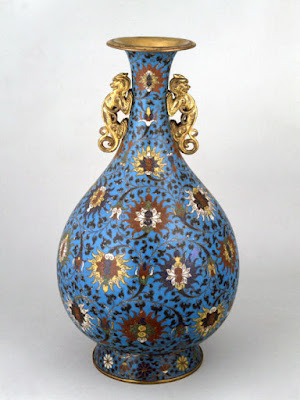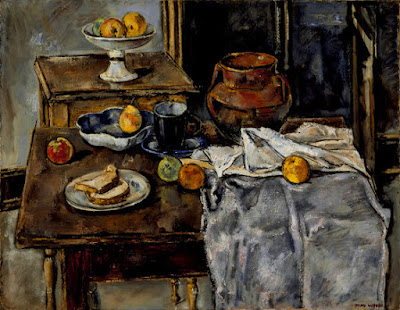 |
| Werner Jacobsz van den Valckert Self Portrait 1612 etching British Museum |
 |
| Werner Jacobsz van den Valckert Young Couple with Raging Death 1612 etching Museum of Fine Arts, Boston |
 |
| Werner Jacobsz van den Valckert Sleeping Venus surprised by Satyrs 1612 etching Museum of Fine Arts, Boston |
 |
| Werner Jacobsz van den Valckert The Good Samaritan ca. 1620 etching British Museum |
 |
| Chinese Culture Funerary Mask 300-100 BC bronze Asian Art Museum, San Francisco |
-550-BC-bronze-Asian-Art-Museum-San-Francisco.jpeg) |
| Chinese Culture Ritual Bell 550 BC bronze Asian Art Museum, San Francisco |
-300-220-BC-bronze-inlaid-with-gold-and-silver-Asian-Art-Museum-San-Francisco.jpeg) |
| Chinese Culture Finial (for Staff) 300-220 BC bronze inlaid with gold and silver Asian Art Museum, San Francisco |
 |
| Chinese Culture Vase with Lotus Scrolls 18th century bronze with cloisonné enamel Asian Art Museum, San Francisco |
 |
| Alvin Langdon Coburn Vortograph 1917 gelatin silver print Los Angeles County Museum of Art |
 |
| Alvin Langdon Coburn Williamsburg Bridge 1910 photogravure Los Angeles County Museum of Art |
 |
| Alvin Langdon Coburn The Door in the Wall before 1911 photogravure National Gallery of Canada, Ottawa |
 |
| Alvin Langdon Coburn Portrait of artist Max Weber, New York 1911 photogravure Los Angeles County Museum of Art |
 |
| Max Weber The Mirror #2 1928 lithograph Art Institute of Chicago |
 |
| Max Weber Attitudes 1930 gouache on paper Art Institute of Chicago |
 |
| Max Weber Still Life with Two Tables ca. 1934 oil on canvas Los Angeles County Museum of Art |
 |
| Max Weber Bananas 1945 oil on linen Wichita Art Museum, Kansas |
from Letter to Lord Byron
The vogue for Black Mass and the cult of devils
Has sunk. The Good, the Beautiful, the True
Still fluctuate about the lower levels.
Has sunk. The Good, the Beautiful, the True
Still fluctuate about the lower levels.
Joyces are firm and there there's nothing new.
Eliots have hardened just a point or two,
Hopkins are brisk, thanks to some recent boosts,
Hopkins are brisk, thanks to some recent boosts,
There's been some further weakening in Prousts.
I'm saying this to tell you who's the rage,
And not to loose a sneer from my interior.
And not to loose a sneer from my interior.
Because there's snobbery in every age,
Because some names are loved by the superior,
It does not follow they're the least inferior:
For all I know the Beatific Vision's
It does not follow they're the least inferior:
For all I know the Beatific Vision's
On view at all Surrealist Exhibitions.
Now for the spirit of the people. Here
I know I'm treading on more dangerous ground;
I know I'm treading on more dangerous ground;
I know there're many changes in the air,
But know my data too slightly to be sound,
I know, too, I'm inviting the renowned
Retort of all who love the Status Quo:
"You can't change human nature, don't you know!"
But know my data too slightly to be sound,
I know, too, I'm inviting the renowned
Retort of all who love the Status Quo:
"You can't change human nature, don't you know!"
We're still, it's true, the same shape and appearance,
We haven't changed the way that kissing's done;
We haven't changed the way that kissing's done;
The average man still hates all interference,
Is just as proud still of his new-born son:
Still, like a hen, he likes his private run,
Scratches for self-esteem, and slyly pecks
Is just as proud still of his new-born son:
Still, like a hen, he likes his private run,
Scratches for self-esteem, and slyly pecks
A good deal in the neighbourhood of sex.
But he's another man in many ways:
Ask the cartoonist first, for he knows best.
Where is the John Bull of the good old days,
The swaggering bully with the clumsy jest?
His meaty neck has long been laid to rest,
His acres of self-confidence for sale;
The swaggering bully with the clumsy jest?
His meaty neck has long been laid to rest,
His acres of self-confidence for sale;
He passed away at Ypres and Passchendaele.
Turn to the work of Disney or of Strube;*
There stands our hero in his threadbare seams;
The bowler-hat who strap-hangs in the tube,
And kicks the tyrant only in his dreams,
Trading on pathos, deading all extremes;
The little Mickey with the hidden grudge;
Which is the better, I leave you to judge.
The little Mickey with the hidden grudge;
Which is the better, I leave you to judge.
– W.H. Auden (1936)
*cartoonist Sidney Strube created the "Little Man" – a British everyman